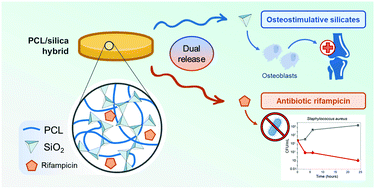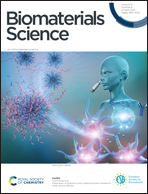Tailored therapeutic release from polycaprolactone-silica hybrids for the treatment of osteomyelitis: antibiotic rifampicin and osteogenic silicates†
Abstract
The treatment of osteomyelitis, a destructive inflammatory process caused by bacterial infections to bone tissue, is one of the most critical challenges of orthopedics and bone regenerative medicine. The standard treatment consists of intense antibiotic therapies combined with tissue surgical debridement and the application of a bone defect filler material. Unfortunately, commercially available candidates, such as gentamicin-impregnated polymethylmethacrylate cements, possess very poor pharmacokinetics (i.e., 24 hours burst release) and little to no regenerative potential. Fostered by the intrinsic limitations associated with conventional treatments, alternative osteostimulative biomaterials with local drug delivery have recently started to emerge. In this study, we propose the use of a polycaprolactone-silica sol–gel hybrid material as carrier for the delivery of rifampicin, an RNA-polymerase blocker often used to treat bone infections, and of osteostimulative silicate ions. The release of therapeutic agents from the material is dual, offering two separate and simultaneous effects, and decoupled, meaning that the kinetics of rifampicin and silicate releases are independent from each other. A series of hybrid formulations with increasing amounts of rifampicin was prepared. The antibiotic loading efficacy, as well as the release profiles of rifampicin and silicates were measured. The characterization of cell viability and differentiation of rat primary osteoblasts and antibacterial performance were also performed. Gram-positive Staphylococcus aureus and Gram-negative Pseudomonas aeruginosa and Escherichia coli were selected due to their high occurrence in bone infections. Results confirmed that rifampicin can be successfully loaded within the hybrids without significant degradation and that it is possible to tailor the antibiotic release according to need. Once in a physiological environment, the rapid release of silicates was associated with optimal cell proliferation and the overexpression of osteoblastic differentiation. Simultaneously, rifampicin is delivered over the course of several weeks with significant inhibition of all tested strains. In particular, the materials caused a growth reduction of 7–10 orders of magnitude in Staphylococcus aureus, the major strain responsible for osteomyelitis worldwide. Our data strongly suggest that PCL/silica hybrids are a very promising candidate to develop bone fillers with superior biological performance compared to currently available options. Thanks to their unique synthesis route and their dual tailored release they can promote bone regeneration while reducing the risk of infection for several weeks upon implantation.

- This article is part of the themed collections: Biomaterials Science Recent HOT Articles and 31st Annual Conference of the European Society of Biomaterials


 Please wait while we load your content...
Please wait while we load your content...